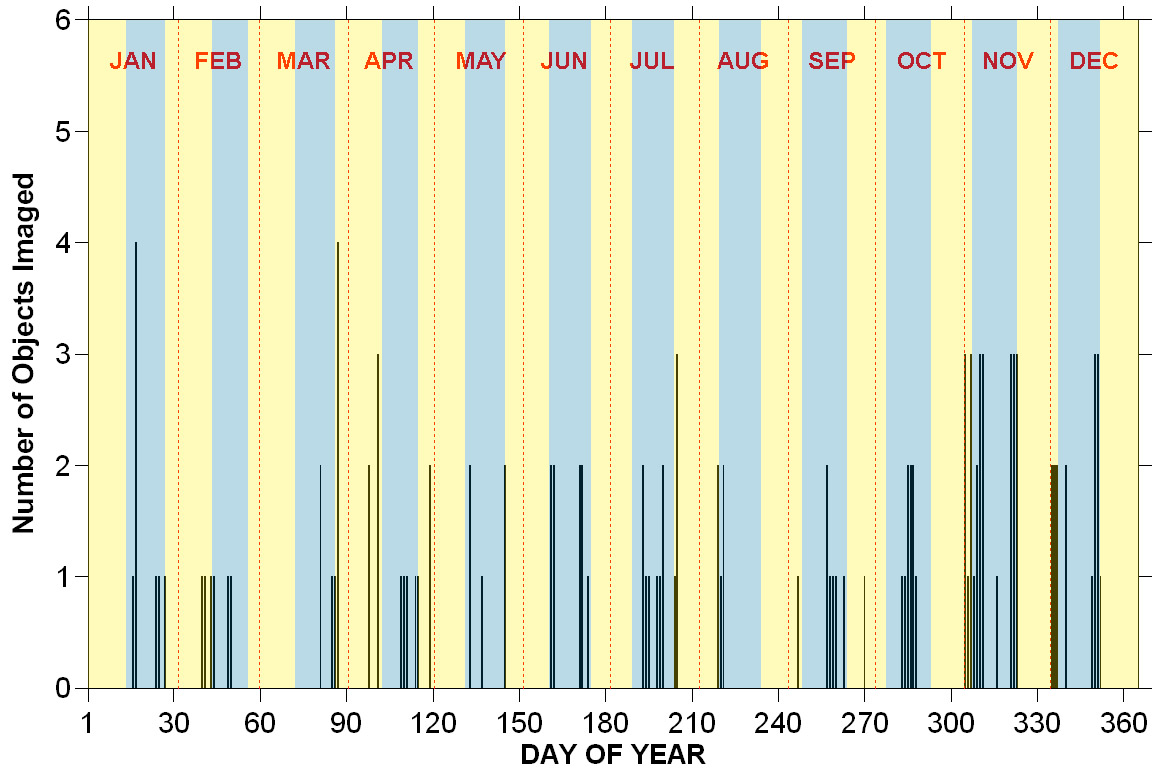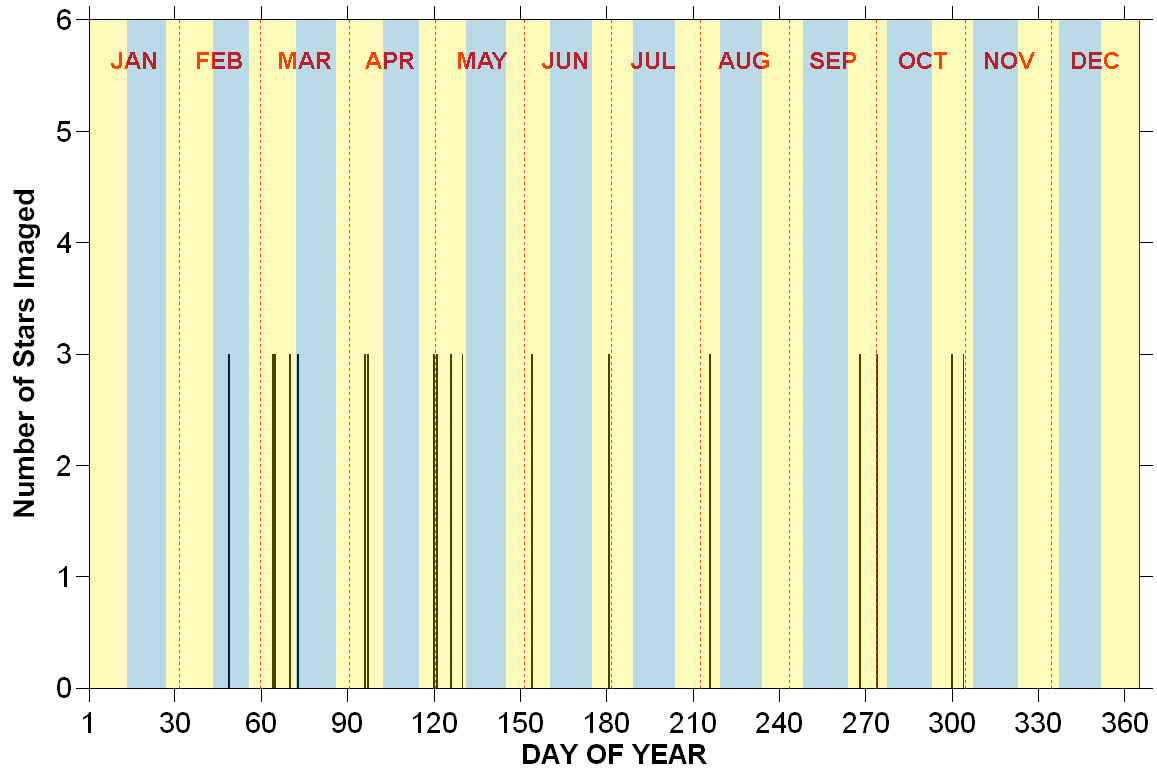
 | SOCO Blog |
10 January 2016
A YEAR OF IMAGING
Now that 2015 is finished, it's a good time to look back and see what got accomplished during that year. The new Optec TCF-S3i focuser was installed in the SOCO imaging system at the end of 2014, putting an end to the focusing problems that had plagued the system in the previous years. The new focuser allowed the imaging procedure to be much more efficient, so that I spent less time focusing and more time actually imaging. So, how much imaging did I get done during the year, and how was the imaging distributed over the months? I keep a logbook of all my imaging at SOCO, but just looking through its pages doesn't really give a good picture of the imaging effort. So, I turned the information in the logbook into a graph (Figure 1) that depicts on what days imaging occurred, and how many objects were imaged in those sessions. When I say the "day" on which imaging occurred, I mean the night starting after sundown on that day. For example, the imaging session starting after dark on Day 16 (January 16) might extend over into the early morning hours of Day 17 (January 17)— this would be considered the imaging session on Day 16.
As any astro-imager of deep-sky objects will tell you, you can't image much when the Moon is bright. So, you would expect imaging sessions to cluster around the times of the New Moon. In Figure 1, I've indicated the periods from first quarter through full Moon to last quarter (yellow) and from last quarter through new Moon to first quarter (blue). I find that, once the waxing Moon gets past first quarter, it tends to make the night sky too bright for effectively imaging most deep-sky objects. So, looking at Figure 1, one can see that most of the imaging sessions occurred between last quarter and first quarter. Note that some imaging sessions occurred at the time of first quarter or a day or so after first quarter— these are instances where I stayed up late and started the imaging session after the Moon set. Also, some imaging sessions occurred at last quarter or a day or so before last quarter— these are instances where I did the imaging before the Moon rose that night. But, in general, the time during the month around full moon had to be avoided. There were two notable exceptions. The last imaging session in April was made when the moon was quite bright (85% of the disk illuminated). Ultimately, I chose to re-shoot those sets of images on later dates due to the bright sky background (well, it was worth a try). However, the imaging session on Day 270 (September 27) occurred during full Moon and was a complete success. This was a very special case— the imaging session occurred during totality of the lunar eclipse on that night!

Figure 1. Days (vertical black bars) with imaging at SOCO in 2015. Dashed vertical red lines delineate the months. Period from Moon's first quarter through full to last quarter indicated in yellow; period from Moon's last quarter through new to first quarter indicated in blue.
During 2015, I think I did some imaging on most of the "good" nights. You might wonder why there are substantial gaps in the imaging effort on nights during the "moonless" part of many months. Well, I probably would have been imaging if the $&#@! clouds would have let me. In all, I imaged on 75 nights during 2015 (about 20% of the year). That's quite a bit more than in each of the previous two years, which is largely the result of working out many of the earlier technical problems in the SOCO imaging system.
As shown in Figure 1, on some nights I imaged only a single astronomical object, while on others I was able to image up to four different objects. This is largely the result on how long the set of exposures took. On the nights when I imaged four objects, these were usually open clusters— all the imaging for an open cluster can be done in a little more than an hour. Many other objects (nebulas, galaxies) require much longer exposures. In fact, the imaging for some objects can carry over from one night to another night (maybe several nights). Also, some objects were re-shot on later dates because I wasn't satisfied with the original set of images. So, the actual total number of individual astronomical objects imaged during 2015 was considerably less that what might be suggested by Figure 1. Referring to my logbook, I estimate that I imaged 84 individual astronomical objects during 2015. Many have made it into the Image Gallery.
Some things can be done on clear nights with bright moonlight. As I describe in the image processing section of this website, this is a good time to acquire imagery of stars that can be analyzed to determine the values of atmospheric extinction coefficients. These values of extinction coefficients are needed in the processing of imagery to produce "true-color" renditions of astronomical objects. During 2015, I acquired imagery of stars for determining the values of atmospheric extinction coefficients on 18 nights. These are shown in Figure 4. As the figure indicates, most of these imaging sessions occurred when the Moon was fairly bright. It was my practice in 2015 to acquire imagery of three stars in an imaging session. The data derived from these imaging sessions went into my extinction coefficient climatology.

Figure 2. Days (vertical black bars) in 2015 when imagery was acquired for determining atmospheric extinction coefficients. Dashed vertical red lines delineate the months. Period from Moon's first quarter through full to last quarter indicated in yellow; period from Moon's last quarter through new to first quarter indicated in blue.
So, 2015 was a pretty productive year in terms of astronomical imaging at SOCO. I probably would have acquired imagery on more days, but the latter part of 2015 was dominated by "El Nino" conditions which usually bring clouds to the American Southwest. The new year (2016) is starting out a bit slow, due to a continuation of the cloudy (and snowy) conditions. Here's hoping the weather will begin to settle down soon and SOCO can get back in operation.
 Return to SOCO Blog Page
Return to SOCO Blog Page
 Return to SOCO Main Page
Return to SOCO Main Page
Questions or comments? Email SOCO@cat-star.org